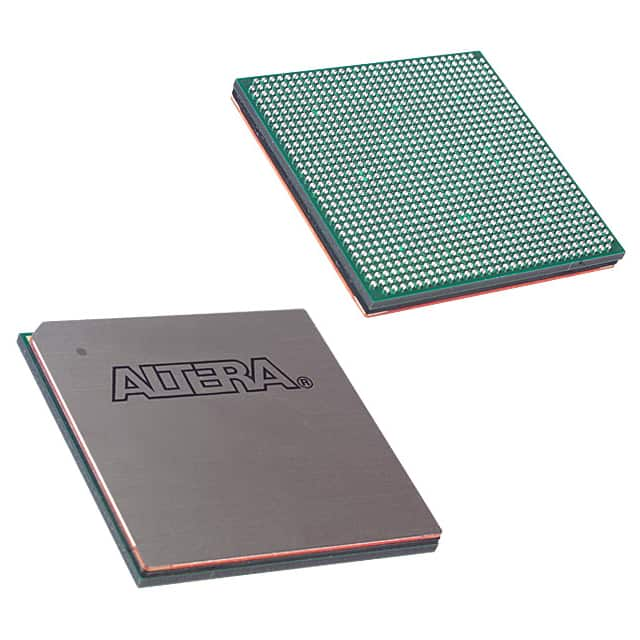Lihat spesifikasi untuk detail produk.

EP2S60F1020C5
Product Overview
- Category: Field Programmable Gate Array (FPGA)
- Use: EP2S60F1020C5 is a high-performance FPGA designed for various applications in the field of digital logic design and signal processing.
- Characteristics: This FPGA offers a large number of programmable logic elements, high-speed I/O interfaces, and embedded memory blocks. It provides flexibility and reconfigurability to meet the demands of complex digital systems.
- Package: The EP2S60F1020C5 comes in a compact and durable package suitable for integration into electronic devices.
- Essence: EP2S60F1020C5 is a key component in the development of advanced digital systems, enabling designers to implement custom logic functions and algorithms.
- Packaging/Quantity: The FPGA is typically sold individually or in small quantities, depending on the manufacturer's packaging options.
Specifications
- Logic Elements: EP2S60F1020C5 contains 60,000 programmable logic elements, allowing for complex digital designs.
- I/O Interfaces: It features multiple high-speed I/O interfaces, including LVDS, differential signaling, and general-purpose I/O pins.
- Memory Blocks: The FPGA includes embedded memory blocks for efficient data storage and retrieval.
- Clock Management: EP2S60F1020C5 incorporates advanced clock management circuitry for precise timing control.
- Operating Voltage: The FPGA operates at a standard voltage level of 3.3V.
Pin Configuration
The detailed pin configuration of EP2S60F1020C5 can be found in the manufacturer's datasheet or reference manual. It provides a comprehensive overview of the input/output pins, power supply connections, and other essential signals.
Functional Features
EP2S60F1020C5 offers several functional features that enhance its usability and performance:
- Reconfigurability: The FPGA can be reprogrammed to adapt to changing design requirements, allowing for flexibility in system development.
- High-Speed Interfaces: It supports various high-speed interfaces, enabling seamless integration with other components and external devices.
- Embedded Memory: The embedded memory blocks provide efficient data storage and retrieval capabilities, reducing the need for external memory components.
- Advanced Clock Management: The FPGA's clock management circuitry ensures precise timing control, critical for synchronous digital systems.
Advantages and Disadvantages
Advantages: - Flexibility and reconfigurability - High-performance logic elements - Multiple I/O interface options - Embedded memory blocks
Disadvantages: - Complexity of programming and design implementation - Higher power consumption compared to fixed-function ASICs - Limited availability of alternative models with similar specifications
Working Principles
EP2S60F1020C5 operates based on the principles of field programmable gate arrays. It consists of a matrix of programmable logic elements interconnected through configurable routing resources. These logic elements can be programmed to implement custom logic functions and algorithms. The FPGA's functionality is determined by the configuration data loaded into it during initialization.
Application Field Plans
EP2S60F1020C5 finds applications in various fields, including but not limited to: - Digital signal processing - Communications systems - Industrial automation - Aerospace and defense - Medical equipment - Research and development
Alternative Models
While EP2S60F1020C5 is a unique FPGA model, there are alternative models available from different manufacturers that offer similar capabilities. Some popular alternatives include: - Xilinx Virtex-7 series - Intel (formerly Altera) Stratix V series - Lattice Semiconductor ECP5 series
These alternative models provide comparable performance and features, allowing designers to choose the most suitable FPGA for their specific application requirements.
Word count: 457 words
Sebutkan 10 pertanyaan dan jawaban umum terkait penerapan EP2S60F1020C5 dalam solusi teknis
Sure! Here are 10 common questions and answers related to the application of EP2S60F1020C5 in technical solutions:
Q: What is EP2S60F1020C5? A: EP2S60F1020C5 is a field-programmable gate array (FPGA) manufactured by Altera (now Intel). It is part of the Stratix II family of FPGAs.
Q: What are the key features of EP2S60F1020C5? A: EP2S60F1020C5 offers 60,000 logic elements, 1,020 user I/O pins, embedded memory blocks, high-speed transceivers, and various other features for implementing complex digital designs.
Q: What are some typical applications of EP2S60F1020C5? A: EP2S60F1020C5 can be used in a wide range of applications such as telecommunications, networking equipment, industrial automation, video processing, and high-performance computing.
Q: How do I program EP2S60F1020C5? A: EP2S60F1020C5 can be programmed using the Quartus Prime software provided by Intel. The design is implemented using a hardware description language (HDL) like Verilog or VHDL.
Q: Can EP2S60F1020C5 be reprogrammed after deployment? A: Yes, EP2S60F1020C5 is a reprogrammable FPGA, allowing you to modify and update the design even after it has been deployed in a system.
Q: What is the maximum operating frequency of EP2S60F1020C5? A: The maximum operating frequency of EP2S60F1020C5 depends on the design and implementation. It can support high-speed designs up to several hundred megahertz or even gigahertz.
Q: Does EP2S60F1020C5 support external memory interfaces? A: Yes, EP2S60F1020C5 has dedicated pins and built-in controllers for interfacing with various types of external memory, such as DDR SDRAM, QDR SRAM, and flash memory.
Q: Can EP2S60F1020C5 interface with other devices or protocols? A: Yes, EP2S60F1020C5 supports various communication protocols like PCIe, Ethernet, USB, SPI, I2C, and UART, allowing it to interface with a wide range of devices and systems.
Q: What is the power consumption of EP2S60F1020C5? A: The power consumption of EP2S60F1020C5 depends on the design and utilization. It is recommended to refer to the datasheet and use power estimation tools provided by Intel.
Q: Are there any development boards available for EP2S60F1020C5? A: Yes, Intel provides development kits and evaluation boards specifically designed for EP2S60F1020C5, which include all the necessary components and interfaces for prototyping and testing.
Please note that the answers provided here are general and may vary depending on specific requirements and implementations.

